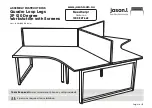
4-8
4.3.12 Power Transistor Replacement
Caution: This device contains components that
can be damaged by static electricity. Proper
handling by grounding of personnel during
servicing is mandatory.
All RF Power Supply and RF Amp components
mounted to the heatsink may be replaced.
Use
only components supplied by CONMED.
Follow these instructions for replacement:
1) No thermal compound is necessary, but the
mating surfaces of the transistor, insulator
pad and surface of casting should be clean.
Always replace the insulator pad associated
with the transistor. Always fasten or clamp
the part to the heat sink surface prior to sol-
dering it to the board. This will assure good
thermal contact is maintained.
2) In order to maintain alignment with the heat
sink surface, the leads of these parts have been
bent to the proper shape. They should be
purchased from CONMED with bent leads.
3) When installing the RF Amp transistors or
diodes, be sure to orient the Bellville washer
as shown with the convex surface next to the
head of the screw. Tighten screws to 5-7 inch
pounds.
4) When installing the RF Power Supply transis-
tors or diodes, replace components as shown
and ensure the insulating tube is installed over
the clip. Locate the part on the clip so that
the bend of the clip is approximately centered
on the body of the part as shown. Tighten
screw to 8-10 in-lbs. When tightening screw,
hold the clip to prevent it from rotating.
Clamp the part to the heatsink surface prior
to soldering to the board.
4.4 Cleaning
The interior of the unit may be vacuumed or
blown out as required. The exterior of the unit
may be cleaned by wiping it with a cloth that
has been dampened (not dripping) with a mild
detergent such as Windex® or Formula 409®.
Windex® is a registered trademark of the S.C.
Johnson Company. Formula 409® is a registered
trademark of the Clorox Company.
4.5
Periodic Inspection
The System 5000™ should be visually inspected
at least every six months. This inspection should
include checks for the following:
1) Damage to the power cord and plug.
2) The proper mating and absence of damage to
the accessory connectors.
3) Any obvious external or internal damage to
the unit.
4) An accumulation of lint or debris within the
unit or heatsink.
5) Control Panel cuts, punctures, or dents.
















































